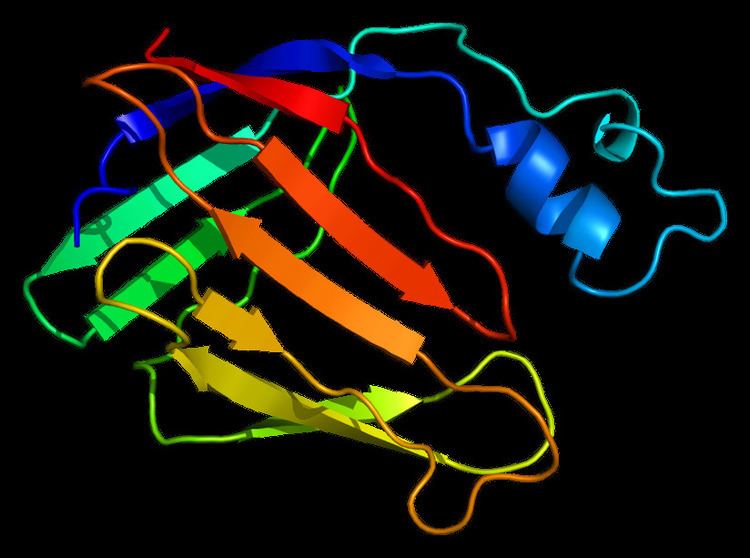Entrez 1382 | Ensembl ENSG00000143320 | |
 | ||
External IDs MGI: 88491 HomoloGene: 1415 GeneCards: CRABP2 | ||
Cellular retinoic acid-binding protein 2 is a cytoplasmic binding protein that in humans is encoded by the CRABP2 gene.
Contents
CRABP2 is structurally similar to CRABP1, but CRABP2 has a lower affinity for retinoic acid (RA). CRABP2 is associated with cells that produce large amounts of retinoic acid and may play a role in mediating the effects of retinoic acid in the cell.
Function
A number of specific carrier proteins for members of the vitamin A family have been discovered. Retinoic acid is an active metabolite of vitamin A (retinol). Cellular retinoic acid binding proteins (CRABP) are low molecular weight proteins whose precise function remains largely unknown.
The inducibility of the CRABP2 gene suggests that this isoform is important in retinoic acid-mediated regulation of human skin growth, differentiation and development. CRABP2 is involved in the metabolism and transportation of retinoic acid from the cytosol to the RARs (retinoic acid receptors) located in the nucleus. CRABP2 is specifically co-expressed with RAR-β and cellular retinol binding protein 1 genes in certain tissues. It has been postulated that the CRABP2 gene is transcriptionally regulated by a newly synthesized regulatory protein.
Tissue distribution
Tissue distribution of the CRABP2 gene has primarily been studied using mouse models. During embryonic development, CRABP2 is present in tissues throughout the body in a more diffuse pattern than CRABP1. CRABP1 is more isolated to specific regions, though it does appear in higher concentrations. CRABP1 and 2 often overlap in tissues.
CRABP2 gene expression is abundant in the trunk and hindbrain (and to a lesser extent the forebrain), but are present in other areas of the body. Structures such as the limbs, hindbrain and cranial neural crest cells have been shown to be excessively sensitive to high levels of retinoic acid. Rhombomere segmentation in the hindbrain and the development of cranial ganglia V, VII, VIII, IX, and X also appear to be partially dependent on CRABP2 expression. CRABP2 is abundant in the dorsal part of the limb during development.
CRABP2 genes are also expressed in structures that are less sensitive to retinoid levels throughout the body during embryonic development. These structures include the pharyngeal pouches, foregut, midgut, mandibular and frontal mesenchyme, developing muscle, interdigital mesenchyme, the urogenital system, optic vessels, and inner ear sensory epithelium.
Defects
Vitamin A deficiency in mice has been shown to cause problems with spermatogenesis, irregular estrous cycles, changes in the uterine epithelium and reproductive failure ending with fetal death and reabsorption.
Tissues with CRABP2 can be sensitive to high levels of retinoic acid which may cause defects in the development of those tissues.
CRABP2 gene knockout studies should be performed to determine any specific defects caused by loss of this gene.
Interactions
CRABP2 has been shown to interact with Cyclin D3.
